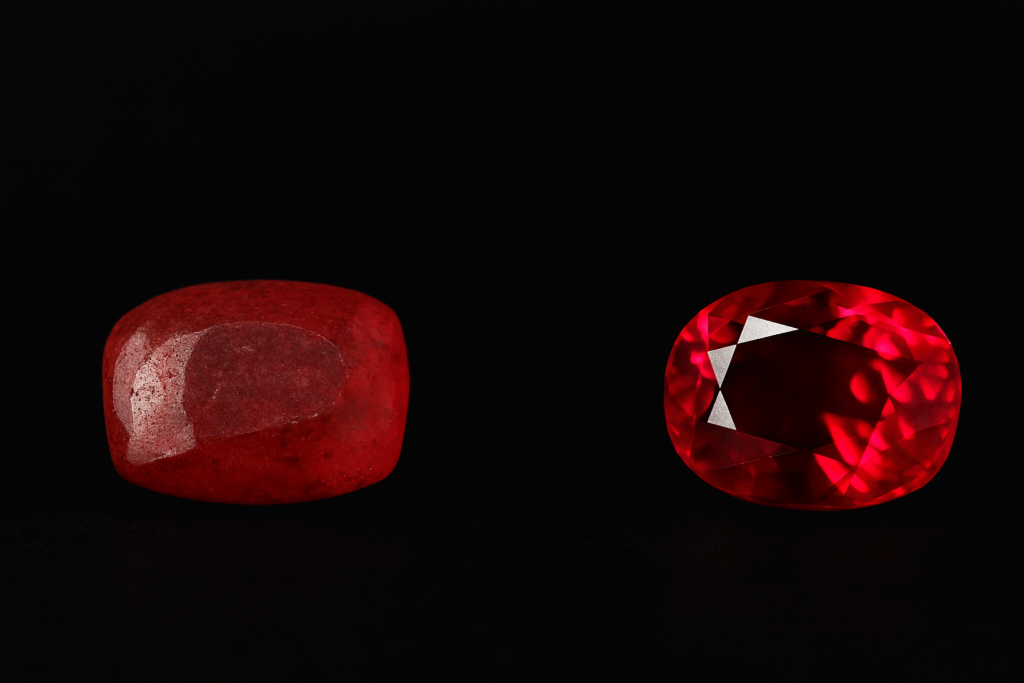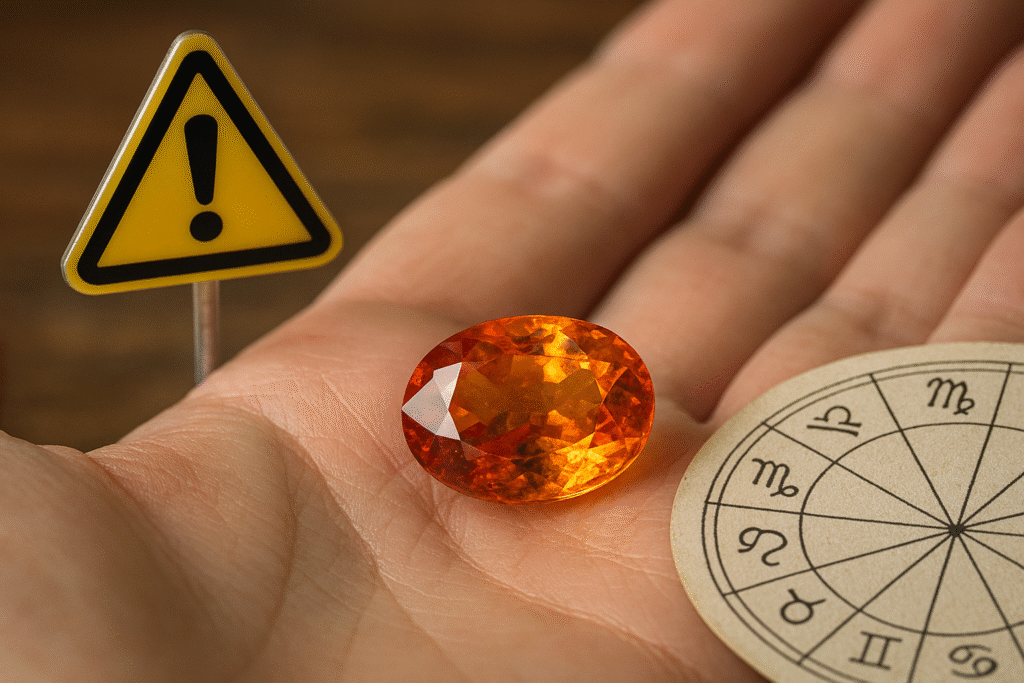When beginners buy sapphires, they often repeat the same sapphire cut mistake. They focus only on size or color while ignoring the cut. Yet, the cut is the soul of the stone because it controls brilliance.
A poor cut causes two common problems:
- Windows – light leaks out through see-through areas.
- Extinction – light gets trapped, creating dark patches.
Both issues make a sapphire look dull. Even a 5-carat stone loses life if the cut is wrong. By contrast, a smaller sapphire with ideal proportions shines brighter and carries more value.
“Brilliance depends on cut, not carat weight.”
Why Cut Defines Value
Case Study: Two Stones, Same Weight
For example, dealers compared two sapphires of equal weight.
- The first stone had a shallow cut, so it lost 40% of light through a window.
- The second stone had balanced proportions, therefore it returned almost 90% of light.
As a result, the well-cut gem sold faster and at a higher price. Buyers recognized the sparkle instantly.
What Buyers Prefer
Research confirms this. Surveys show that 62% of sapphire buyers prefer brilliance over carat weight. Because of this, cut remains the top factor driving real market value.
Expert Advice on Avoiding Mistakes
With over 40 years in the gemstone trade, I have seen many collectors regret their sapphire cut mistake. Once jewelers set a poorly cut stone, flaws in brilliance stand out clearly.
Don’t rely only on carat or color. Instead, always check how the stone reflects light before you pay for it.
👉 If you are learning, read Shopping for Gems: A Beginner’s Guide for practical tips.
FAQ: Sapphire Cut Mistakes
What is the biggest sapphire cut mistake?
Many buyers focus only on size or color. Because they ignore cut, even rare stones lose their brilliance.
What does a sapphire window mean?
A shallow cut creates a window where light leaks through. As a result, the stone appears flat and lifeless.
Can extinction be avoided?
Yes. A deep cut causes extinction, but if you choose proper angles, you can reduce the dark areas.
Can a poor cut be fixed?
A skilled cutter can improve brilliance. However, recutting reduces weight and increases cost, so weigh options carefully.
Where can I learn more about jewelry quality?
Read Understanding BIS Hallmark: What It Means for Your Jewellery to understand purity standards. Additionally, this article explains how to verify metal quality before purchase.
For more information about gemstone grading, visit the Gemological Institute of America (GIA), a trusted authority in the field.
This comprehensive global cuisine FAQ covers everything about Asian and Western food and drinks. Whether you’re exploring international cooking techniques or discovering new flavors, this global cuisine FAQ answers the most frequently asked questions about world food traditions, ingredients, and culinary practices from both Eastern and Western cultures.
Global Cuisine FAQ: Asian & Western Food & Drinks
Food reveals cultural contrasts in clear and delicious ways. From cooking methods to dining customs, Asian and Western cuisines showcase unique traditions while also offering fascinating overlaps. Below, you’ll find answers to the most common questions about these culinary worlds.
Understanding Core Differences in Cuisine
1. What distinguishes Asian and Western culinary traditions?
Asian meals often rely on rice or noodles as a foundation. Flavors usually come from soy sauce, ginger, garlic, and a wide variety of spices. Meanwhile, Western gastronomy emphasizes bread, potatoes, and pasta. Dairy plays a key role, with butter, cream, and cheese giving richness to many dishes. Herbs such as rosemary and thyme highlight European cooking. These contrasts create distinct dining habits and flavor profiles.
2. Are Asian dishes always spicy?
No, not at all. While cuisines from Thailand and parts of India feature bold use of chilies, not every dish follows this pattern. Japanese sushi, Chinese dim sum, and Korean bulgogi are mild examples. In fact, Asian cuisines range from fiery to delicate, showcasing a rich palette of flavor.
Western Breakfast Staples and Comfort Foods
1. What constitutes typical Western morning meals?
Western breakfasts often include eggs, bacon, and toast. Pancakes, waffles, and cereal are also popular choices. These hearty starts are usually enjoyed with coffee, tea, or juice, providing both energy and comfort.
2. What represents popular Western comfort foods?
Comfort foods in the West speak to nostalgia and indulgence. Creamy macaroni and cheese, pizza, and hearty casseroles are favorites. Similarly, burgers and fried chicken have wide appeal. Because they are warm, filling, and familiar, these dishes strongly connect to emotion.
Cultural Dining Practices
1. Do all Asian cultures employ chopsticks?
No. Chopsticks dominate in East Asia—China, Japan, and Korea. However, Southeast Asia prefers spoons and forks, while India and parts of the Middle East often use flatbreads or hands. This diversity highlights how food customs closely reflect culture.
2. Why are some Asian foods fermented?
Fermentation preserves food while also enhancing nutrition and flavor. Korean kimchi, Japanese miso, and Indonesian tempeh show how tradition meets health benefits. These foods are valued not only for taste but also for their role in well-being.
Common Western Beverages
1. What beverages are common with Western meals?
Western dining often features water, soda, or fresh juice. Alcohol also has a strong cultural connection, with wine served at European dinners and beer central in North America. In the southern United States, sweet iced tea is a staple.
Dietary Flexibility and Options
1. Can one discover plant-based options easily?
Yes. Asian cuisines offer tofu stir-fries, lentil dals, and vegetable curries that are naturally vegetarian. Western food, similarly, embraces plant-based eating. Salads, vegetarian pastas, and vegan burgers have grown popular, making meat-free dining accessible worldwide.
Unique Asian Drinks to Explore
1. What are some unique Asian beverages?
Asia provides a wide variety of distinctive drinks. Bubble tea, from Taiwan, combines tea with chewy tapioca pearls. Japanese sake, made from rice, holds deep cultural meaning. Strong Vietnamese iced coffee, sweetened with condensed milk, adds a bold twist compared to Western brews.
Portion Sizes and Dining Habits
1. How do portion sizes compare?
Western meals often emphasize large servings, reflecting abundance. By contrast, Asian meals are usually smaller yet balanced, encouraging sharing and mindful eating. This creates different social experiences around the table.
The Art of Fusion Cuisine
1. Is it feasible to integrate Asian and Western flavors?
Absolutely. Fusion cuisine blends traditions in creative ways. For instance, teriyaki burgers combine Japanese flavors with American fast food, while kimchi tacos bring Korean spice to Mexican street food. These playful mixes show how food bridges cultures.



